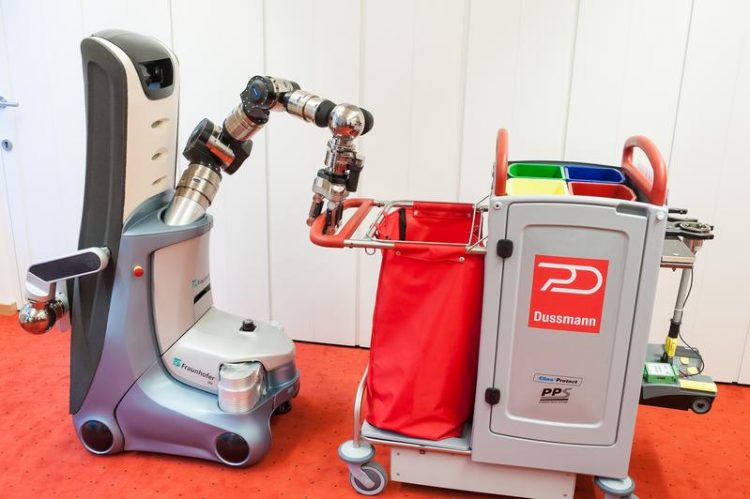Modular and versatile: key technologies for robot-assisted cleaning

Care-O-bot pulls its cleaning and tool cart to the work site. source: Dussmann Group/Ecke
Seventy percent of professional building cleaning work consists of cleaning floors and disposing of waste. Demographic change is one reason why less and less qualified cleaning staff is available. One possible solution is to automate such work. As part of the AutoPnP collaborative project, scientists at Fraunhofer IPA have developed the necessary software functionalities.
Cleaning floors and emptying waste-paper baskets
In the course of daily floor-cleaning, a robot scans offices for any dirt, which is removed using a cleaning device. First, the robot navigates its way autonomously through open offices to inspect the floor surfaces. Dirt is automatically detected, mapped and then removed by the robot using a battery-powered vacuum cleaner. Next, the cleaning result is checked and, if required, communicated to the human operator.
Using algorithms for object classification, the robot is also able to detect waste-paper baskets, which it grasps with its arm and empties into a collection bin. “In December last year, the cleaning contractor Dussmann in Berlin carried out initial user tests, which successfully demonstrated the feasibility of such cleaning applications using currently available technology,” says Richard Bormann, Research Assistant in the Robot and Assistive Systems department. For professional cleaning contractors like Dussmann, these positive results hold out the prospect in a few years’ time of putting this technology to cost-effective use with suitably customized robot systems in order to make up for the growing shortage of qualified personnel.
Simple configurability and plug & play
The individual functionalities for robot-assisted cleaning will be presented at Automatica 2014. Implementation of the application scenario is based on a further development of the “Care-O-bot 3” mobile robot assistant, which was originally designed to provide assistance in a domestic setting. However, a modular software architecture, likewise developed as part of the project, made it possible for “Care-O-bot 3” to be quickly and easily transformed into a cleaning robot.
The same software architecture was used to realize the plug & play functionalities required for performing the cleaning task. This allows the robotic arm to be interchangeably equipped with functional attachments, such as a robotic hand or battery-powered vacuum cleaner. The new equipment is automatically detected by the control software. “The modular software architecture makes it possible to easily transfer the concept to a low-cost robot platform specially tailored to this particular application,” says Bormann.
AutoPnP
A standardized software architecture and modular middleware are what is needed to combine different robot systems within a common system while at the same time being quickly able to adapt them for different applications. In addition to the “Robot-assisted Cleaning” scenario, “Home Automation” and “Convertible Factory” are further applications for which the developed software architecture is used within the AutoPnP collaborative project.
The AutoPnP collaborative project stands for “Plug & Play for Automation Systems” and is sponsored by the German Ministry of Economics and Energy (BMWi).
Consortium partners
Fraunhofer IPA | fortiss GmbH | Technische Universität Berlin/DAI-Labor | Dussmann AG | Schunk GmbH | Festo AG | Festo Didactic GmbH & Co. KG
Hannover Trade Fair 2014
7 to 11 April 2014
Automatica – 6th International Trade Fair for Automation and Mechatronics
3 to 6 June 2014
New Trade Fair Centre Munich
Contact
Dipl.-Ing. Richard Bormann M. Sc., phone +49 711 970-1062, richard.bormann@ipa.fraunhofer.de
http://www.autopnp.com
http://www.ipa.fraunhofer.de
http://www.automatica-munich.com
http://www.hannovermesse.de
Media Contact
All latest news from the category: Trade Fair News
Newest articles

Parallel Paths: Understanding Malaria Resistance in Chimpanzees and Humans
The closest relatives of humans adapt genetically to habitats and infections Survival of the Fittest: Genetic Adaptations Uncovered in Chimpanzees Görlitz, 10.01.2025. Chimpanzees have genetic adaptations that help them survive…

You are What You Eat—Stanford Study Links Fiber to Anti-Cancer Gene Modulation
The Fiber Gap: A Growing Concern in American Diets Fiber is well known to be an important part of a healthy diet, yet less than 10% of Americans eat the minimum recommended…

Trust Your Gut—RNA-Protein Discovery for Better Immunity
HIRI researchers uncover control mechanisms of polysaccharide utilization in Bacteroides thetaiotaomicron. Researchers at the Helmholtz Institute for RNA-based Infection Research (HIRI) and the Julius-Maximilians-Universität (JMU) in Würzburg have identified a…



